HI5014 T2 2019: Amazon Multinational Entity Analysis Report
VerifiedAdded on 2022/11/22
|15
|2980
|237
Report
AI Summary
This report provides a comprehensive analysis of Amazon as a multinational entity, examining its international strategies. It delves into the foreign market entry strategies employed by Amazon, such as detailed customer understanding, adaptation of artificial intelligence, expansion of logistics, and localization of research and development. The report assesses the competitive dynamics and market conditions faced by Amazon, including its key competitors like E-Bay, Walmart, and Flipkart, and the competitive strategies it uses to maintain its market position. Furthermore, the report explores Amazon's organizational structure, highlighting its hierarchical pattern and its ability to adapt to changes globally. The report also touches upon knowledge management and innovation within Amazon, offering a holistic view of the company's approach to international business expansion and success.
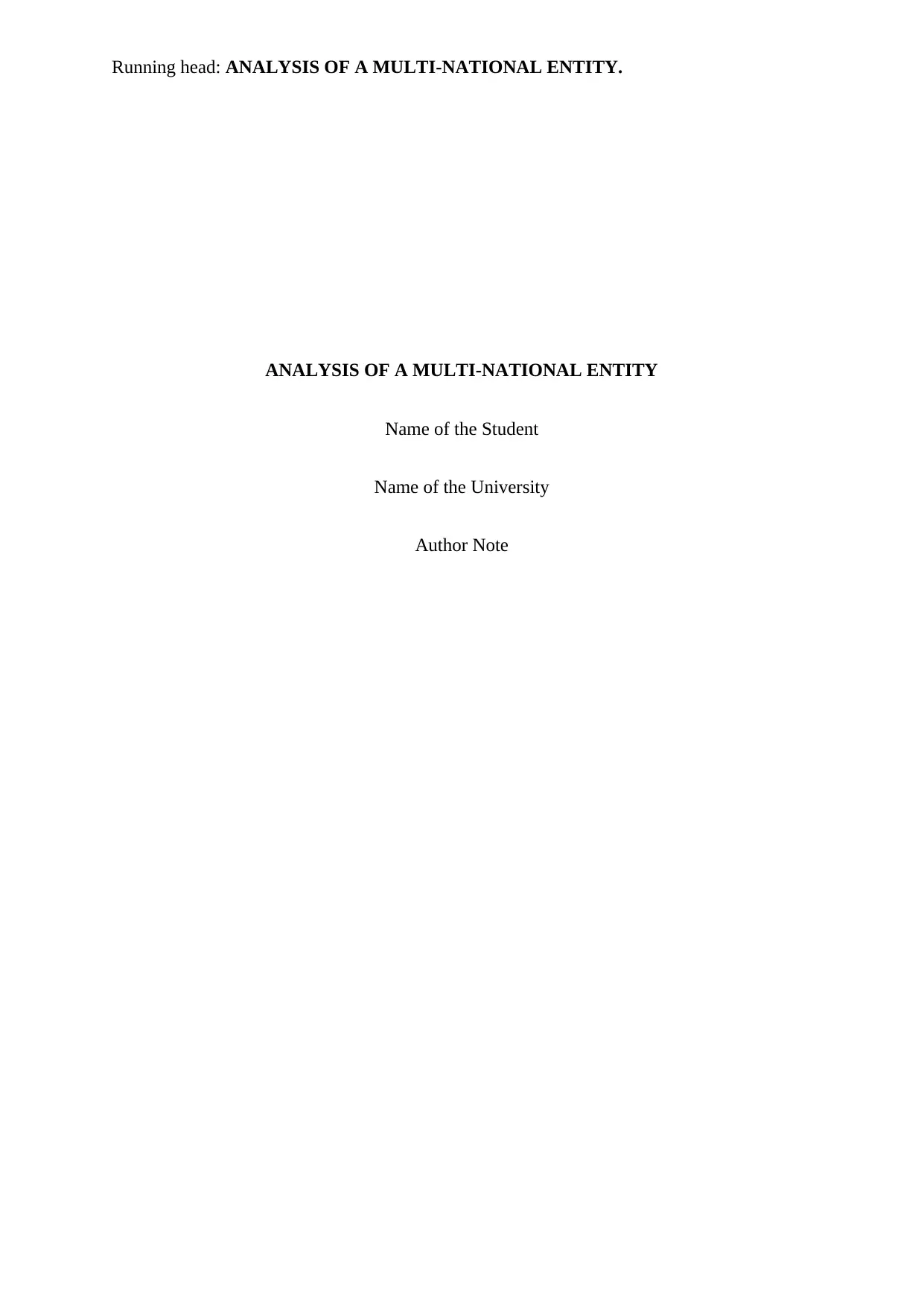
Running head: ANALYSIS OF A MULTI-NATIONAL ENTITY.
ANALYSIS OF A MULTI-NATIONAL ENTITY
Name of the Student
Name of the University
Author Note
ANALYSIS OF A MULTI-NATIONAL ENTITY
Name of the Student
Name of the University
Author Note
Paraphrase This Document
Need a fresh take? Get an instant paraphrase of this document with our AI Paraphraser
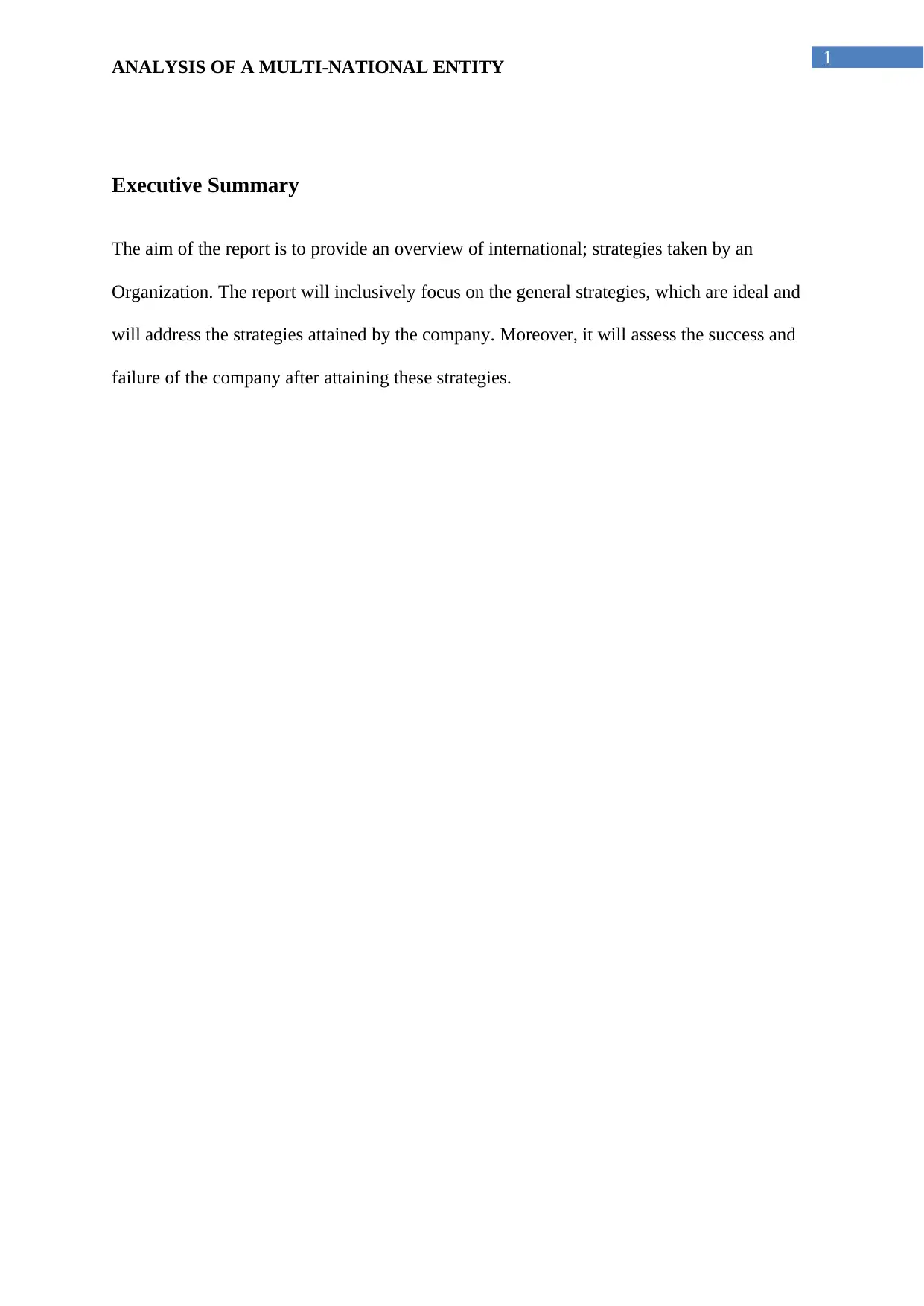
1
ANALYSIS OF A MULTI-NATIONAL ENTITY
Executive Summary
The aim of the report is to provide an overview of international; strategies taken by an
Organization. The report will inclusively focus on the general strategies, which are ideal and
will address the strategies attained by the company. Moreover, it will assess the success and
failure of the company after attaining these strategies.
ANALYSIS OF A MULTI-NATIONAL ENTITY
Executive Summary
The aim of the report is to provide an overview of international; strategies taken by an
Organization. The report will inclusively focus on the general strategies, which are ideal and
will address the strategies attained by the company. Moreover, it will assess the success and
failure of the company after attaining these strategies.

2
ANALYSIS OF A MULTI-NATIONAL ENTITY
ANALYSIS OF A MULTI-NATIONAL ENTITY
⊘ This is a preview!⊘
Do you want full access?
Subscribe today to unlock all pages.

Trusted by 1+ million students worldwide
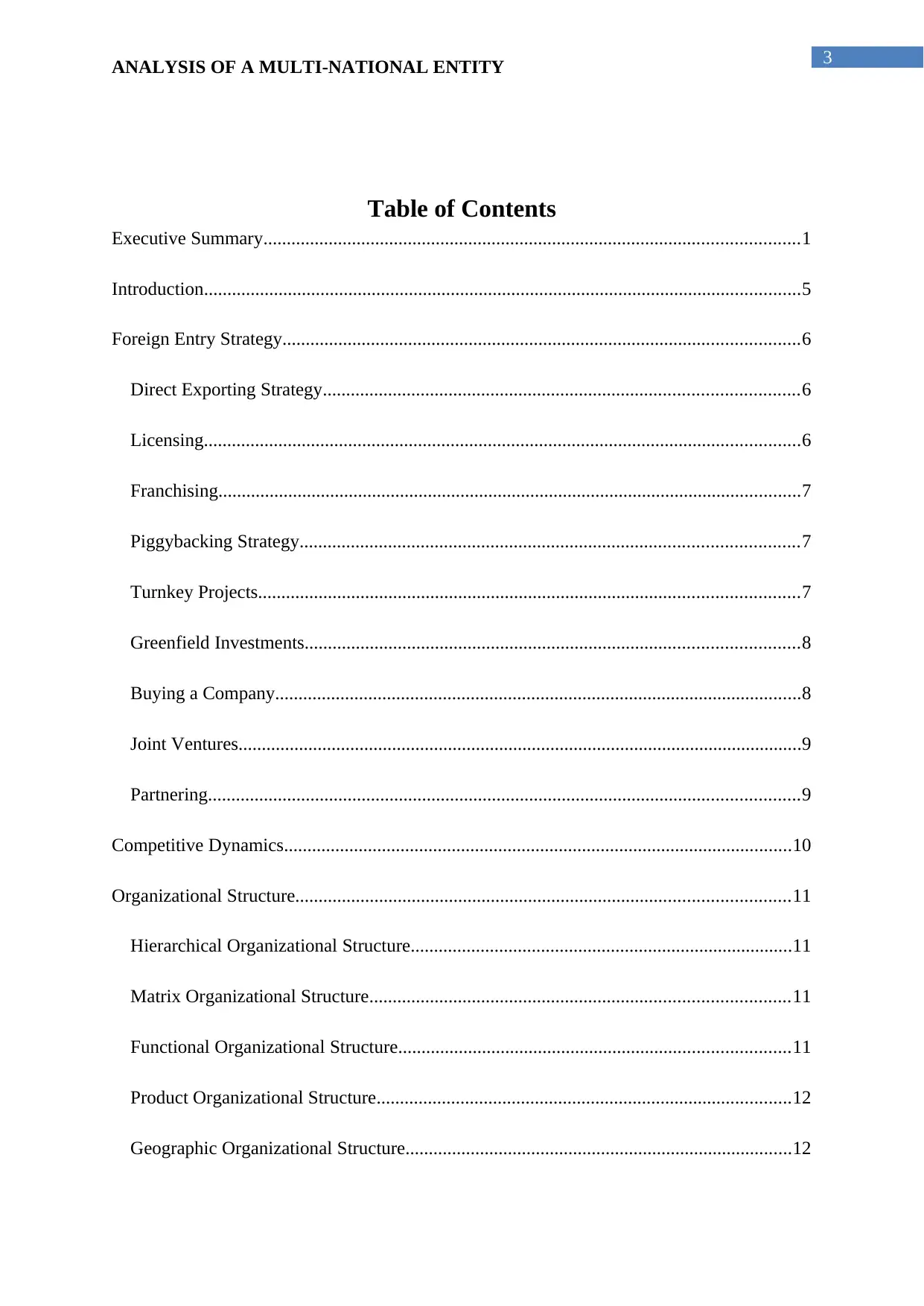
3
ANALYSIS OF A MULTI-NATIONAL ENTITY
Table of Contents
Executive Summary...................................................................................................................1
Introduction................................................................................................................................5
Foreign Entry Strategy...............................................................................................................6
Direct Exporting Strategy......................................................................................................6
Licensing................................................................................................................................6
Franchising.............................................................................................................................7
Piggybacking Strategy...........................................................................................................7
Turnkey Projects....................................................................................................................7
Greenfield Investments..........................................................................................................8
Buying a Company.................................................................................................................8
Joint Ventures.........................................................................................................................9
Partnering...............................................................................................................................9
Competitive Dynamics.............................................................................................................10
Organizational Structure..........................................................................................................11
Hierarchical Organizational Structure..................................................................................11
Matrix Organizational Structure..........................................................................................11
Functional Organizational Structure....................................................................................11
Product Organizational Structure.........................................................................................12
Geographic Organizational Structure...................................................................................12
ANALYSIS OF A MULTI-NATIONAL ENTITY
Table of Contents
Executive Summary...................................................................................................................1
Introduction................................................................................................................................5
Foreign Entry Strategy...............................................................................................................6
Direct Exporting Strategy......................................................................................................6
Licensing................................................................................................................................6
Franchising.............................................................................................................................7
Piggybacking Strategy...........................................................................................................7
Turnkey Projects....................................................................................................................7
Greenfield Investments..........................................................................................................8
Buying a Company.................................................................................................................8
Joint Ventures.........................................................................................................................9
Partnering...............................................................................................................................9
Competitive Dynamics.............................................................................................................10
Organizational Structure..........................................................................................................11
Hierarchical Organizational Structure..................................................................................11
Matrix Organizational Structure..........................................................................................11
Functional Organizational Structure....................................................................................11
Product Organizational Structure.........................................................................................12
Geographic Organizational Structure...................................................................................12
Paraphrase This Document
Need a fresh take? Get an instant paraphrase of this document with our AI Paraphraser

4
ANALYSIS OF A MULTI-NATIONAL ENTITY
Customer Organizational Structure......................................................................................12
Knowledge Management.........................................................................................................13
Innovation................................................................................................................................13
Conclusion................................................................................................................................14
References................................................................................................................................15
Appendix..................................................................................................................................17
ANALYSIS OF A MULTI-NATIONAL ENTITY
Customer Organizational Structure......................................................................................12
Knowledge Management.........................................................................................................13
Innovation................................................................................................................................13
Conclusion................................................................................................................................14
References................................................................................................................................15
Appendix..................................................................................................................................17
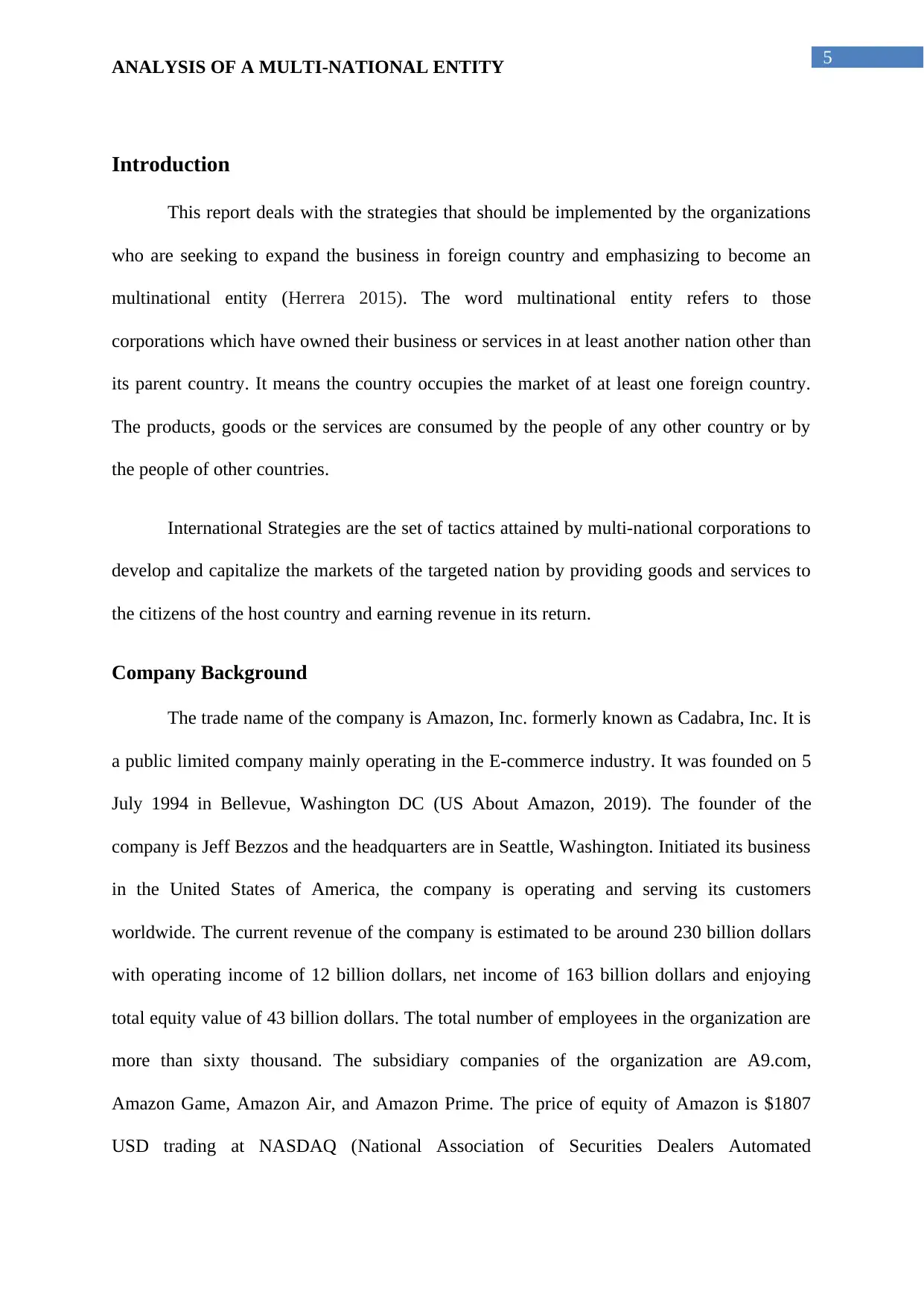
5
ANALYSIS OF A MULTI-NATIONAL ENTITY
Introduction
This report deals with the strategies that should be implemented by the organizations
who are seeking to expand the business in foreign country and emphasizing to become an
multinational entity (Herrera 2015). The word multinational entity refers to those
corporations which have owned their business or services in at least another nation other than
its parent country. It means the country occupies the market of at least one foreign country.
The products, goods or the services are consumed by the people of any other country or by
the people of other countries.
International Strategies are the set of tactics attained by multi-national corporations to
develop and capitalize the markets of the targeted nation by providing goods and services to
the citizens of the host country and earning revenue in its return.
Company Background
The trade name of the company is Amazon, Inc. formerly known as Cadabra, Inc. It is
a public limited company mainly operating in the E-commerce industry. It was founded on 5
July 1994 in Bellevue, Washington DC (US About Amazon, 2019). The founder of the
company is Jeff Bezzos and the headquarters are in Seattle, Washington. Initiated its business
in the United States of America, the company is operating and serving its customers
worldwide. The current revenue of the company is estimated to be around 230 billion dollars
with operating income of 12 billion dollars, net income of 163 billion dollars and enjoying
total equity value of 43 billion dollars. The total number of employees in the organization are
more than sixty thousand. The subsidiary companies of the organization are A9.com,
Amazon Game, Amazon Air, and Amazon Prime. The price of equity of Amazon is $1807
USD trading at NASDAQ (National Association of Securities Dealers Automated
ANALYSIS OF A MULTI-NATIONAL ENTITY
Introduction
This report deals with the strategies that should be implemented by the organizations
who are seeking to expand the business in foreign country and emphasizing to become an
multinational entity (Herrera 2015). The word multinational entity refers to those
corporations which have owned their business or services in at least another nation other than
its parent country. It means the country occupies the market of at least one foreign country.
The products, goods or the services are consumed by the people of any other country or by
the people of other countries.
International Strategies are the set of tactics attained by multi-national corporations to
develop and capitalize the markets of the targeted nation by providing goods and services to
the citizens of the host country and earning revenue in its return.
Company Background
The trade name of the company is Amazon, Inc. formerly known as Cadabra, Inc. It is
a public limited company mainly operating in the E-commerce industry. It was founded on 5
July 1994 in Bellevue, Washington DC (US About Amazon, 2019). The founder of the
company is Jeff Bezzos and the headquarters are in Seattle, Washington. Initiated its business
in the United States of America, the company is operating and serving its customers
worldwide. The current revenue of the company is estimated to be around 230 billion dollars
with operating income of 12 billion dollars, net income of 163 billion dollars and enjoying
total equity value of 43 billion dollars. The total number of employees in the organization are
more than sixty thousand. The subsidiary companies of the organization are A9.com,
Amazon Game, Amazon Air, and Amazon Prime. The price of equity of Amazon is $1807
USD trading at NASDAQ (National Association of Securities Dealers Automated
⊘ This is a preview!⊘
Do you want full access?
Subscribe today to unlock all pages.

Trusted by 1+ million students worldwide
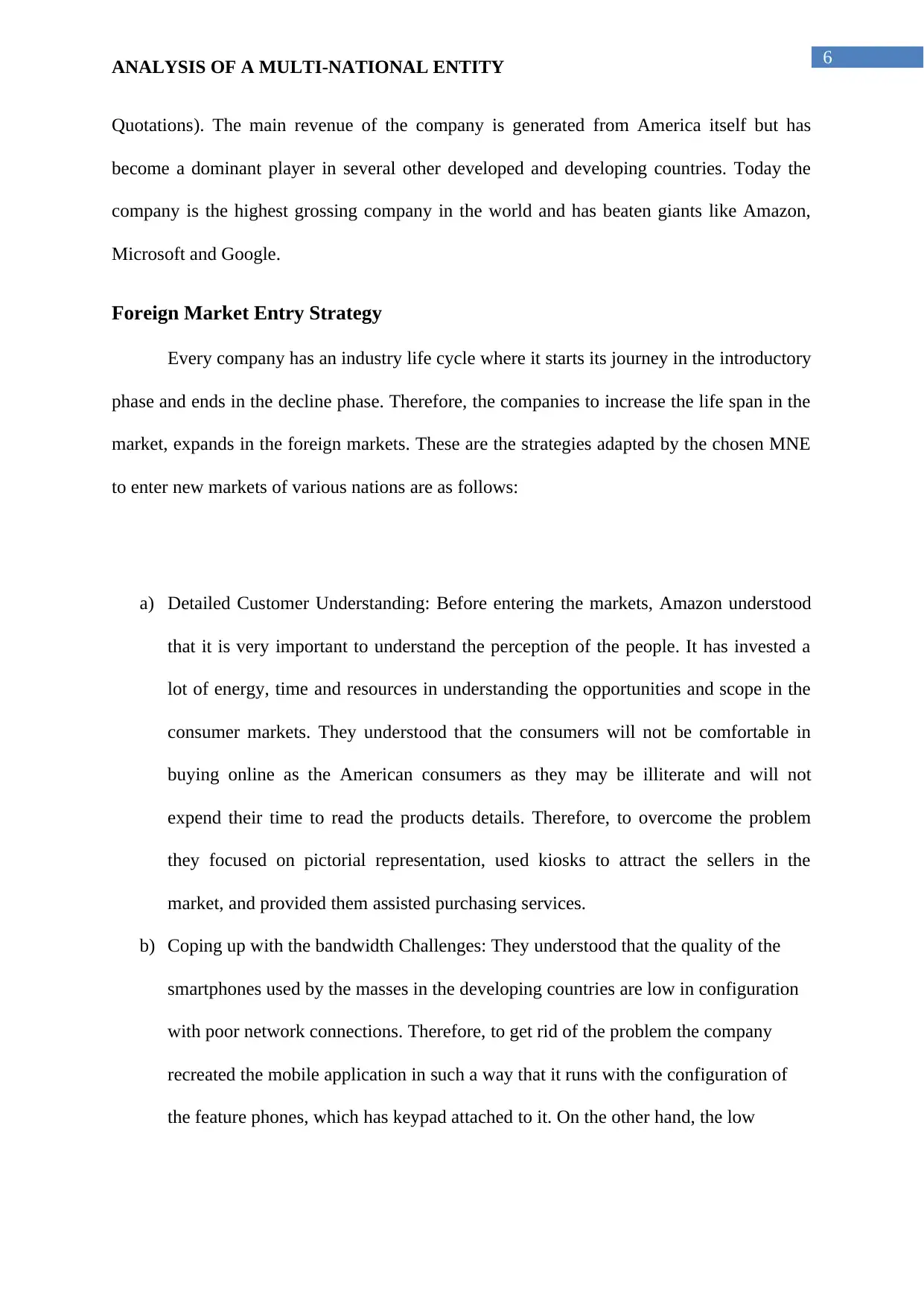
6
ANALYSIS OF A MULTI-NATIONAL ENTITY
Quotations). The main revenue of the company is generated from America itself but has
become a dominant player in several other developed and developing countries. Today the
company is the highest grossing company in the world and has beaten giants like Amazon,
Microsoft and Google.
Foreign Market Entry Strategy
Every company has an industry life cycle where it starts its journey in the introductory
phase and ends in the decline phase. Therefore, the companies to increase the life span in the
market, expands in the foreign markets. These are the strategies adapted by the chosen MNE
to enter new markets of various nations are as follows:
a) Detailed Customer Understanding: Before entering the markets, Amazon understood
that it is very important to understand the perception of the people. It has invested a
lot of energy, time and resources in understanding the opportunities and scope in the
consumer markets. They understood that the consumers will not be comfortable in
buying online as the American consumers as they may be illiterate and will not
expend their time to read the products details. Therefore, to overcome the problem
they focused on pictorial representation, used kiosks to attract the sellers in the
market, and provided them assisted purchasing services.
b) Coping up with the bandwidth Challenges: They understood that the quality of the
smartphones used by the masses in the developing countries are low in configuration
with poor network connections. Therefore, to get rid of the problem the company
recreated the mobile application in such a way that it runs with the configuration of
the feature phones, which has keypad attached to it. On the other hand, the low
ANALYSIS OF A MULTI-NATIONAL ENTITY
Quotations). The main revenue of the company is generated from America itself but has
become a dominant player in several other developed and developing countries. Today the
company is the highest grossing company in the world and has beaten giants like Amazon,
Microsoft and Google.
Foreign Market Entry Strategy
Every company has an industry life cycle where it starts its journey in the introductory
phase and ends in the decline phase. Therefore, the companies to increase the life span in the
market, expands in the foreign markets. These are the strategies adapted by the chosen MNE
to enter new markets of various nations are as follows:
a) Detailed Customer Understanding: Before entering the markets, Amazon understood
that it is very important to understand the perception of the people. It has invested a
lot of energy, time and resources in understanding the opportunities and scope in the
consumer markets. They understood that the consumers will not be comfortable in
buying online as the American consumers as they may be illiterate and will not
expend their time to read the products details. Therefore, to overcome the problem
they focused on pictorial representation, used kiosks to attract the sellers in the
market, and provided them assisted purchasing services.
b) Coping up with the bandwidth Challenges: They understood that the quality of the
smartphones used by the masses in the developing countries are low in configuration
with poor network connections. Therefore, to get rid of the problem the company
recreated the mobile application in such a way that it runs with the configuration of
the feature phones, which has keypad attached to it. On the other hand, the low
Paraphrase This Document
Need a fresh take? Get an instant paraphrase of this document with our AI Paraphraser
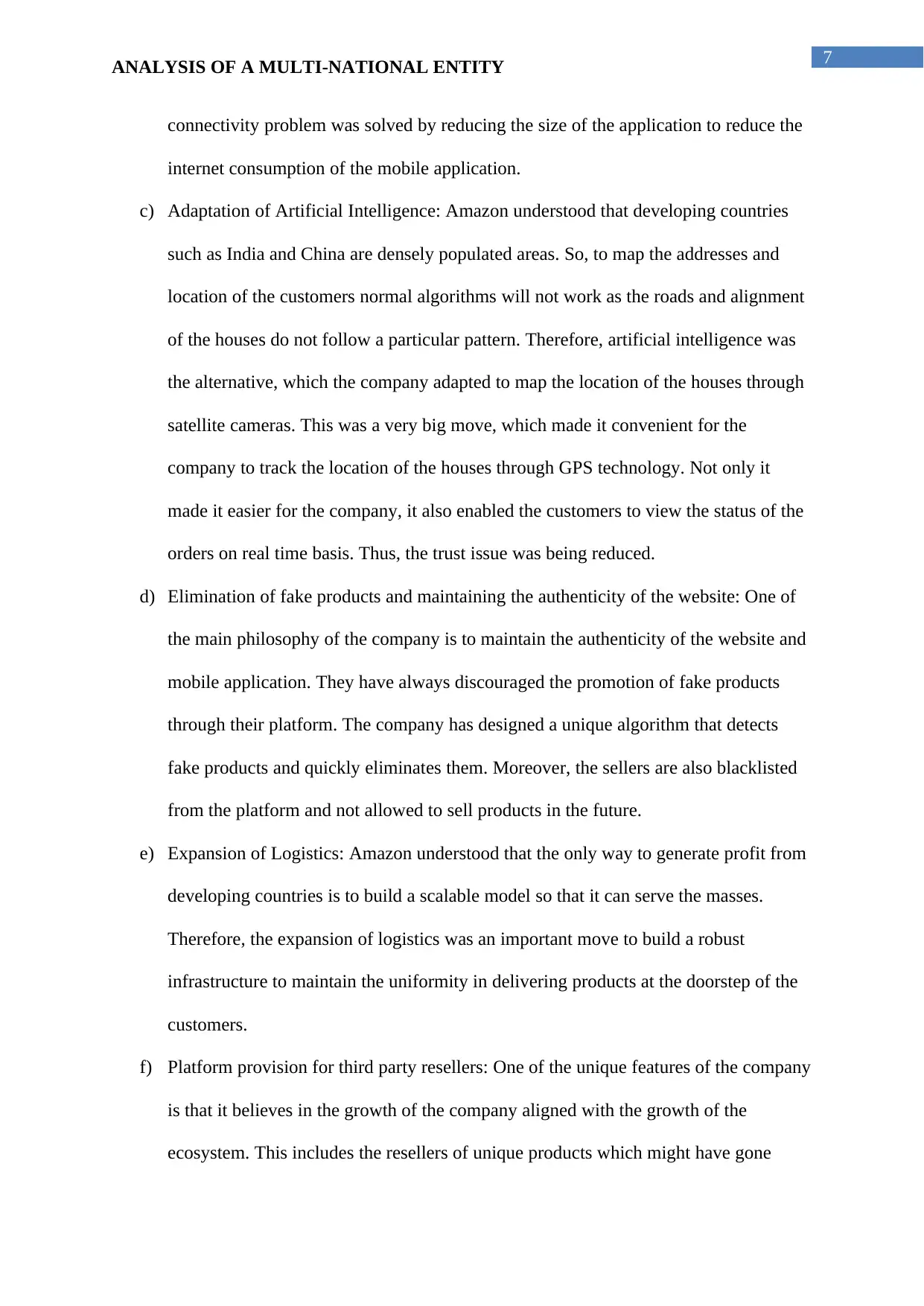
7
ANALYSIS OF A MULTI-NATIONAL ENTITY
connectivity problem was solved by reducing the size of the application to reduce the
internet consumption of the mobile application.
c) Adaptation of Artificial Intelligence: Amazon understood that developing countries
such as India and China are densely populated areas. So, to map the addresses and
location of the customers normal algorithms will not work as the roads and alignment
of the houses do not follow a particular pattern. Therefore, artificial intelligence was
the alternative, which the company adapted to map the location of the houses through
satellite cameras. This was a very big move, which made it convenient for the
company to track the location of the houses through GPS technology. Not only it
made it easier for the company, it also enabled the customers to view the status of the
orders on real time basis. Thus, the trust issue was being reduced.
d) Elimination of fake products and maintaining the authenticity of the website: One of
the main philosophy of the company is to maintain the authenticity of the website and
mobile application. They have always discouraged the promotion of fake products
through their platform. The company has designed a unique algorithm that detects
fake products and quickly eliminates them. Moreover, the sellers are also blacklisted
from the platform and not allowed to sell products in the future.
e) Expansion of Logistics: Amazon understood that the only way to generate profit from
developing countries is to build a scalable model so that it can serve the masses.
Therefore, the expansion of logistics was an important move to build a robust
infrastructure to maintain the uniformity in delivering products at the doorstep of the
customers.
f) Platform provision for third party resellers: One of the unique features of the company
is that it believes in the growth of the company aligned with the growth of the
ecosystem. This includes the resellers of unique products which might have gone
ANALYSIS OF A MULTI-NATIONAL ENTITY
connectivity problem was solved by reducing the size of the application to reduce the
internet consumption of the mobile application.
c) Adaptation of Artificial Intelligence: Amazon understood that developing countries
such as India and China are densely populated areas. So, to map the addresses and
location of the customers normal algorithms will not work as the roads and alignment
of the houses do not follow a particular pattern. Therefore, artificial intelligence was
the alternative, which the company adapted to map the location of the houses through
satellite cameras. This was a very big move, which made it convenient for the
company to track the location of the houses through GPS technology. Not only it
made it easier for the company, it also enabled the customers to view the status of the
orders on real time basis. Thus, the trust issue was being reduced.
d) Elimination of fake products and maintaining the authenticity of the website: One of
the main philosophy of the company is to maintain the authenticity of the website and
mobile application. They have always discouraged the promotion of fake products
through their platform. The company has designed a unique algorithm that detects
fake products and quickly eliminates them. Moreover, the sellers are also blacklisted
from the platform and not allowed to sell products in the future.
e) Expansion of Logistics: Amazon understood that the only way to generate profit from
developing countries is to build a scalable model so that it can serve the masses.
Therefore, the expansion of logistics was an important move to build a robust
infrastructure to maintain the uniformity in delivering products at the doorstep of the
customers.
f) Platform provision for third party resellers: One of the unique features of the company
is that it believes in the growth of the company aligned with the growth of the
ecosystem. This includes the resellers of unique products which might have gone
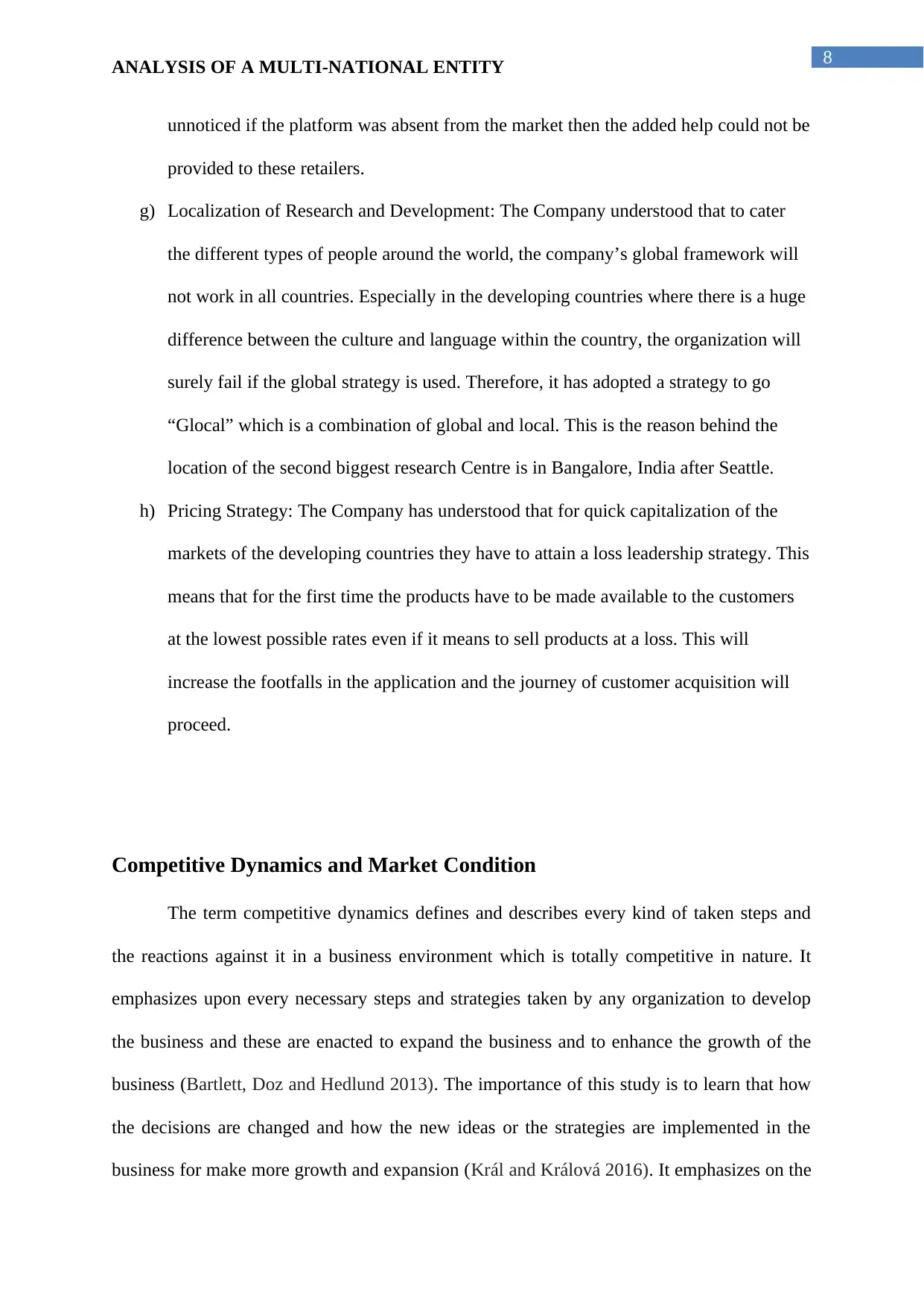
8
ANALYSIS OF A MULTI-NATIONAL ENTITY
unnoticed if the platform was absent from the market then the added help could not be
provided to these retailers.
g) Localization of Research and Development: The Company understood that to cater
the different types of people around the world, the company’s global framework will
not work in all countries. Especially in the developing countries where there is a huge
difference between the culture and language within the country, the organization will
surely fail if the global strategy is used. Therefore, it has adopted a strategy to go
“Glocal” which is a combination of global and local. This is the reason behind the
location of the second biggest research Centre is in Bangalore, India after Seattle.
h) Pricing Strategy: The Company has understood that for quick capitalization of the
markets of the developing countries they have to attain a loss leadership strategy. This
means that for the first time the products have to be made available to the customers
at the lowest possible rates even if it means to sell products at a loss. This will
increase the footfalls in the application and the journey of customer acquisition will
proceed.
Competitive Dynamics and Market Condition
The term competitive dynamics defines and describes every kind of taken steps and
the reactions against it in a business environment which is totally competitive in nature. It
emphasizes upon every necessary steps and strategies taken by any organization to develop
the business and these are enacted to expand the business and to enhance the growth of the
business (Bartlett, Doz and Hedlund 2013). The importance of this study is to learn that how
the decisions are changed and how the new ideas or the strategies are implemented in the
business for make more growth and expansion (Král and Králová 2016). It emphasizes on the
ANALYSIS OF A MULTI-NATIONAL ENTITY
unnoticed if the platform was absent from the market then the added help could not be
provided to these retailers.
g) Localization of Research and Development: The Company understood that to cater
the different types of people around the world, the company’s global framework will
not work in all countries. Especially in the developing countries where there is a huge
difference between the culture and language within the country, the organization will
surely fail if the global strategy is used. Therefore, it has adopted a strategy to go
“Glocal” which is a combination of global and local. This is the reason behind the
location of the second biggest research Centre is in Bangalore, India after Seattle.
h) Pricing Strategy: The Company has understood that for quick capitalization of the
markets of the developing countries they have to attain a loss leadership strategy. This
means that for the first time the products have to be made available to the customers
at the lowest possible rates even if it means to sell products at a loss. This will
increase the footfalls in the application and the journey of customer acquisition will
proceed.
Competitive Dynamics and Market Condition
The term competitive dynamics defines and describes every kind of taken steps and
the reactions against it in a business environment which is totally competitive in nature. It
emphasizes upon every necessary steps and strategies taken by any organization to develop
the business and these are enacted to expand the business and to enhance the growth of the
business (Bartlett, Doz and Hedlund 2013). The importance of this study is to learn that how
the decisions are changed and how the new ideas or the strategies are implemented in the
business for make more growth and expansion (Král and Králová 2016). It emphasizes on the
⊘ This is a preview!⊘
Do you want full access?
Subscribe today to unlock all pages.

Trusted by 1+ million students worldwide
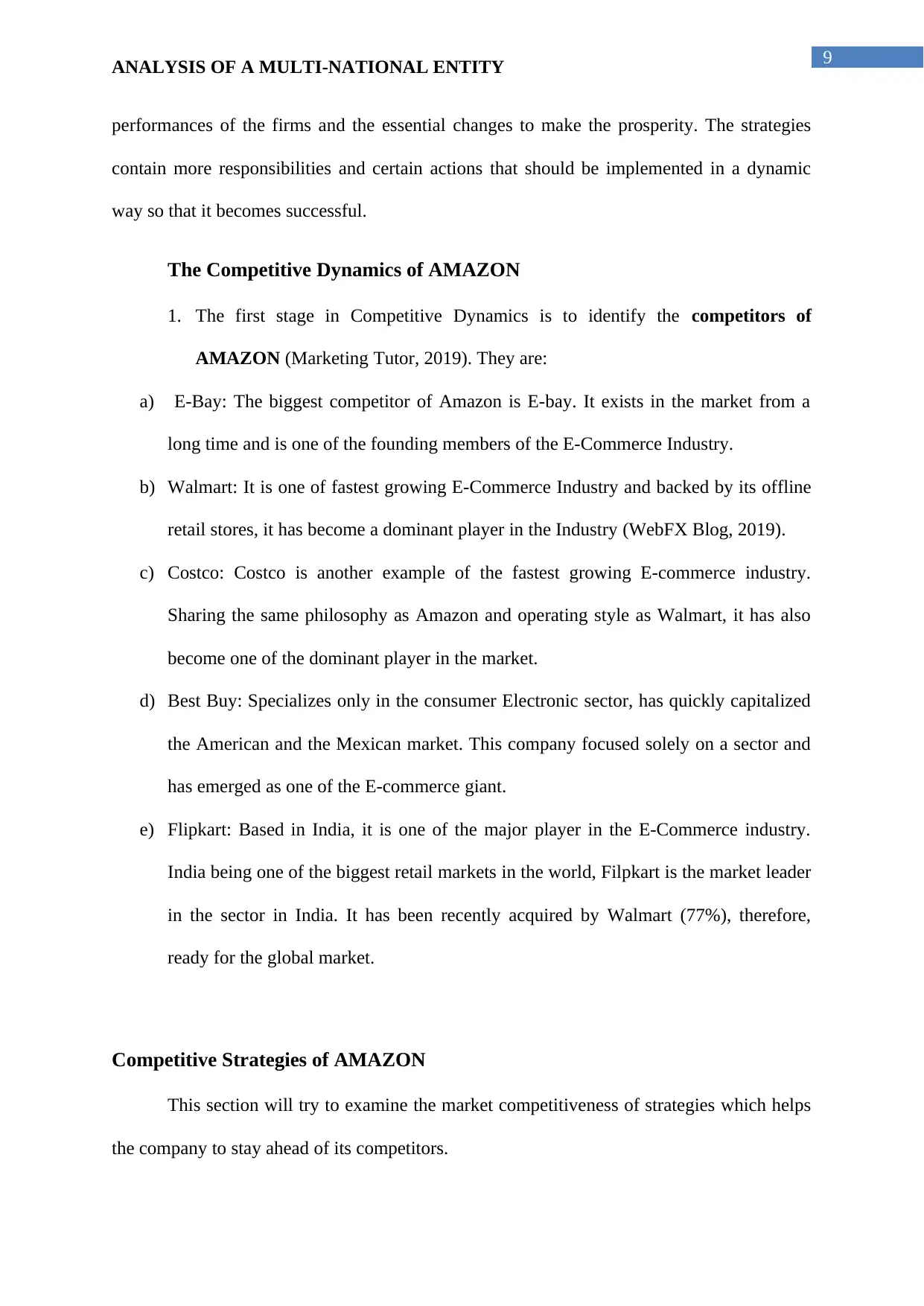
9
ANALYSIS OF A MULTI-NATIONAL ENTITY
performances of the firms and the essential changes to make the prosperity. The strategies
contain more responsibilities and certain actions that should be implemented in a dynamic
way so that it becomes successful.
The Competitive Dynamics of AMAZON
1. The first stage in Competitive Dynamics is to identify the competitors of
AMAZON (Marketing Tutor, 2019). They are:
a) E-Bay: The biggest competitor of Amazon is E-bay. It exists in the market from a
long time and is one of the founding members of the E-Commerce Industry.
b) Walmart: It is one of fastest growing E-Commerce Industry and backed by its offline
retail stores, it has become a dominant player in the Industry (WebFX Blog, 2019).
c) Costco: Costco is another example of the fastest growing E-commerce industry.
Sharing the same philosophy as Amazon and operating style as Walmart, it has also
become one of the dominant player in the market.
d) Best Buy: Specializes only in the consumer Electronic sector, has quickly capitalized
the American and the Mexican market. This company focused solely on a sector and
has emerged as one of the E-commerce giant.
e) Flipkart: Based in India, it is one of the major player in the E-Commerce industry.
India being one of the biggest retail markets in the world, Filpkart is the market leader
in the sector in India. It has been recently acquired by Walmart (77%), therefore,
ready for the global market.
Competitive Strategies of AMAZON
This section will try to examine the market competitiveness of strategies which helps
the company to stay ahead of its competitors.
ANALYSIS OF A MULTI-NATIONAL ENTITY
performances of the firms and the essential changes to make the prosperity. The strategies
contain more responsibilities and certain actions that should be implemented in a dynamic
way so that it becomes successful.
The Competitive Dynamics of AMAZON
1. The first stage in Competitive Dynamics is to identify the competitors of
AMAZON (Marketing Tutor, 2019). They are:
a) E-Bay: The biggest competitor of Amazon is E-bay. It exists in the market from a
long time and is one of the founding members of the E-Commerce Industry.
b) Walmart: It is one of fastest growing E-Commerce Industry and backed by its offline
retail stores, it has become a dominant player in the Industry (WebFX Blog, 2019).
c) Costco: Costco is another example of the fastest growing E-commerce industry.
Sharing the same philosophy as Amazon and operating style as Walmart, it has also
become one of the dominant player in the market.
d) Best Buy: Specializes only in the consumer Electronic sector, has quickly capitalized
the American and the Mexican market. This company focused solely on a sector and
has emerged as one of the E-commerce giant.
e) Flipkart: Based in India, it is one of the major player in the E-Commerce industry.
India being one of the biggest retail markets in the world, Filpkart is the market leader
in the sector in India. It has been recently acquired by Walmart (77%), therefore,
ready for the global market.
Competitive Strategies of AMAZON
This section will try to examine the market competitiveness of strategies which helps
the company to stay ahead of its competitors.
Paraphrase This Document
Need a fresh take? Get an instant paraphrase of this document with our AI Paraphraser
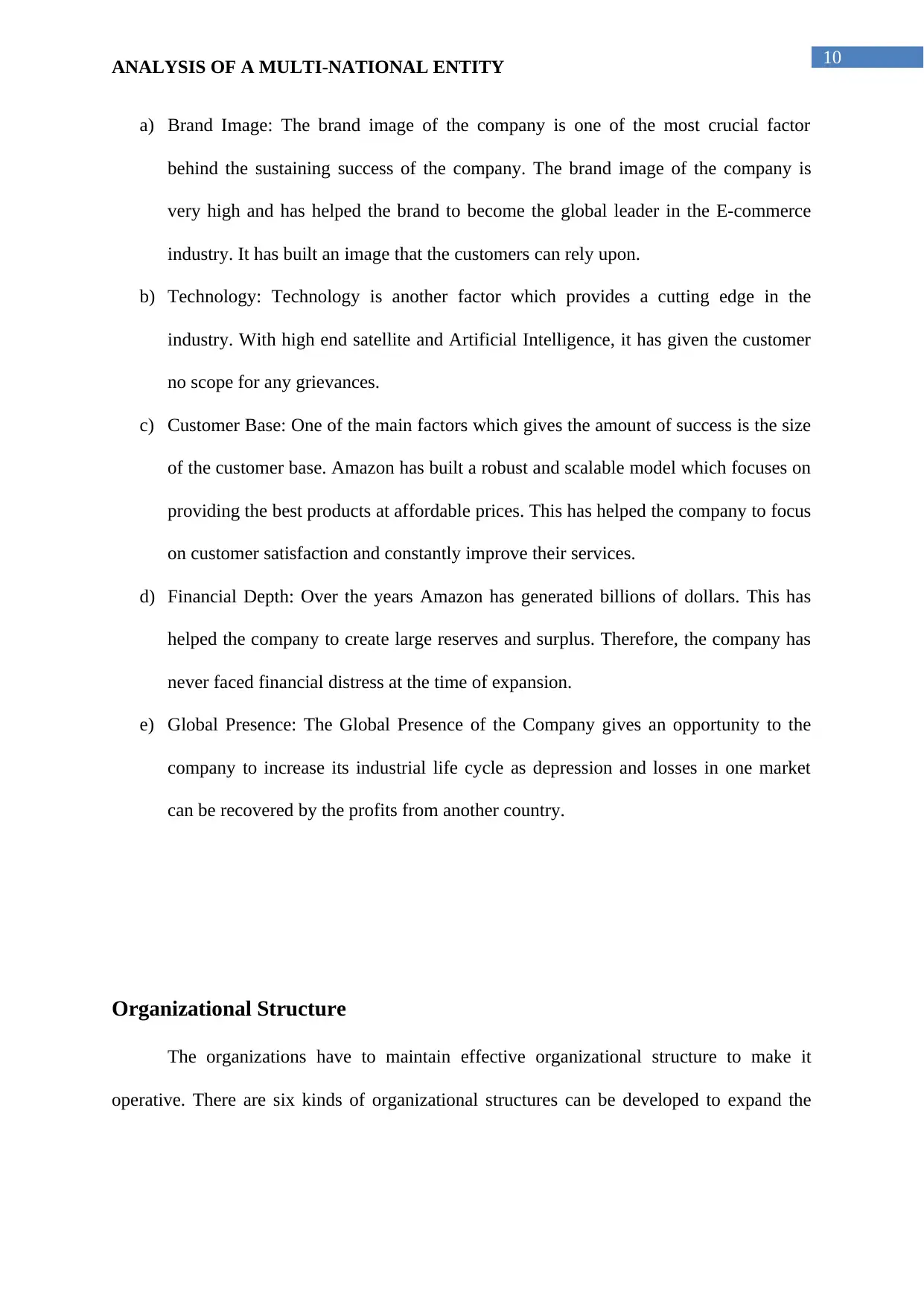
10
ANALYSIS OF A MULTI-NATIONAL ENTITY
a) Brand Image: The brand image of the company is one of the most crucial factor
behind the sustaining success of the company. The brand image of the company is
very high and has helped the brand to become the global leader in the E-commerce
industry. It has built an image that the customers can rely upon.
b) Technology: Technology is another factor which provides a cutting edge in the
industry. With high end satellite and Artificial Intelligence, it has given the customer
no scope for any grievances.
c) Customer Base: One of the main factors which gives the amount of success is the size
of the customer base. Amazon has built a robust and scalable model which focuses on
providing the best products at affordable prices. This has helped the company to focus
on customer satisfaction and constantly improve their services.
d) Financial Depth: Over the years Amazon has generated billions of dollars. This has
helped the company to create large reserves and surplus. Therefore, the company has
never faced financial distress at the time of expansion.
e) Global Presence: The Global Presence of the Company gives an opportunity to the
company to increase its industrial life cycle as depression and losses in one market
can be recovered by the profits from another country.
Organizational Structure
The organizations have to maintain effective organizational structure to make it
operative. There are six kinds of organizational structures can be developed to expand the
ANALYSIS OF A MULTI-NATIONAL ENTITY
a) Brand Image: The brand image of the company is one of the most crucial factor
behind the sustaining success of the company. The brand image of the company is
very high and has helped the brand to become the global leader in the E-commerce
industry. It has built an image that the customers can rely upon.
b) Technology: Technology is another factor which provides a cutting edge in the
industry. With high end satellite and Artificial Intelligence, it has given the customer
no scope for any grievances.
c) Customer Base: One of the main factors which gives the amount of success is the size
of the customer base. Amazon has built a robust and scalable model which focuses on
providing the best products at affordable prices. This has helped the company to focus
on customer satisfaction and constantly improve their services.
d) Financial Depth: Over the years Amazon has generated billions of dollars. This has
helped the company to create large reserves and surplus. Therefore, the company has
never faced financial distress at the time of expansion.
e) Global Presence: The Global Presence of the Company gives an opportunity to the
company to increase its industrial life cycle as depression and losses in one market
can be recovered by the profits from another country.
Organizational Structure
The organizations have to maintain effective organizational structure to make it
operative. There are six kinds of organizational structures can be developed to expand the
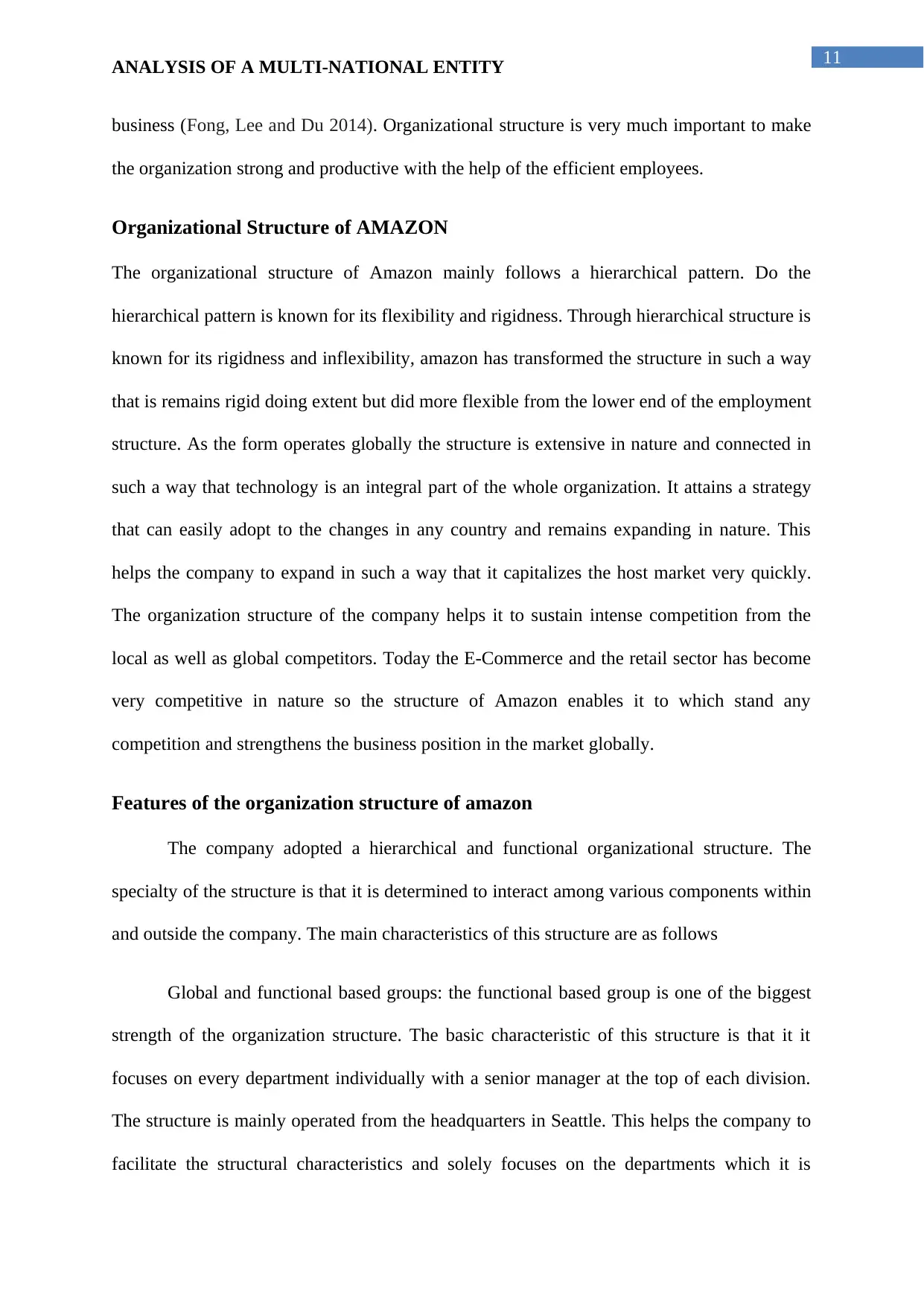
11
ANALYSIS OF A MULTI-NATIONAL ENTITY
business (Fong, Lee and Du 2014). Organizational structure is very much important to make
the organization strong and productive with the help of the efficient employees.
Organizational Structure of AMAZON
The organizational structure of Amazon mainly follows a hierarchical pattern. Do the
hierarchical pattern is known for its flexibility and rigidness. Through hierarchical structure is
known for its rigidness and inflexibility, amazon has transformed the structure in such a way
that is remains rigid doing extent but did more flexible from the lower end of the employment
structure. As the form operates globally the structure is extensive in nature and connected in
such a way that technology is an integral part of the whole organization. It attains a strategy
that can easily adopt to the changes in any country and remains expanding in nature. This
helps the company to expand in such a way that it capitalizes the host market very quickly.
The organization structure of the company helps it to sustain intense competition from the
local as well as global competitors. Today the E-Commerce and the retail sector has become
very competitive in nature so the structure of Amazon enables it to which stand any
competition and strengthens the business position in the market globally.
Features of the organization structure of amazon
The company adopted a hierarchical and functional organizational structure. The
specialty of the structure is that it is determined to interact among various components within
and outside the company. The main characteristics of this structure are as follows
Global and functional based groups: the functional based group is one of the biggest
strength of the organization structure. The basic characteristic of this structure is that it it
focuses on every department individually with a senior manager at the top of each division.
The structure is mainly operated from the headquarters in Seattle. This helps the company to
facilitate the structural characteristics and solely focuses on the departments which it is
ANALYSIS OF A MULTI-NATIONAL ENTITY
business (Fong, Lee and Du 2014). Organizational structure is very much important to make
the organization strong and productive with the help of the efficient employees.
Organizational Structure of AMAZON
The organizational structure of Amazon mainly follows a hierarchical pattern. Do the
hierarchical pattern is known for its flexibility and rigidness. Through hierarchical structure is
known for its rigidness and inflexibility, amazon has transformed the structure in such a way
that is remains rigid doing extent but did more flexible from the lower end of the employment
structure. As the form operates globally the structure is extensive in nature and connected in
such a way that technology is an integral part of the whole organization. It attains a strategy
that can easily adopt to the changes in any country and remains expanding in nature. This
helps the company to expand in such a way that it capitalizes the host market very quickly.
The organization structure of the company helps it to sustain intense competition from the
local as well as global competitors. Today the E-Commerce and the retail sector has become
very competitive in nature so the structure of Amazon enables it to which stand any
competition and strengthens the business position in the market globally.
Features of the organization structure of amazon
The company adopted a hierarchical and functional organizational structure. The
specialty of the structure is that it is determined to interact among various components within
and outside the company. The main characteristics of this structure are as follows
Global and functional based groups: the functional based group is one of the biggest
strength of the organization structure. The basic characteristic of this structure is that it it
focuses on every department individually with a senior manager at the top of each division.
The structure is mainly operated from the headquarters in Seattle. This helps the company to
facilitate the structural characteristics and solely focuses on the departments which it is
⊘ This is a preview!⊘
Do you want full access?
Subscribe today to unlock all pages.

Trusted by 1+ million students worldwide
1 out of 15
Related Documents
Your All-in-One AI-Powered Toolkit for Academic Success.
+13062052269
info@desklib.com
Available 24*7 on WhatsApp / Email
![[object Object]](/_next/static/media/star-bottom.7253800d.svg)
Unlock your academic potential
Copyright © 2020–2025 A2Z Services. All Rights Reserved. Developed and managed by ZUCOL.




